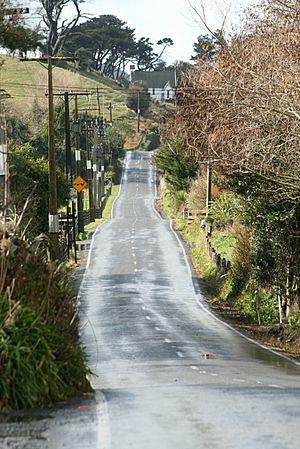Ohariu, New Zealand facts for kids
Quick facts for kids
Ohariu
|
|
|---|---|
|
Suburb
|
|

Ohariu Valley Rd
|
|
| Country | New Zealand |
| Local authority | Wellington |
| Electoral ward |
|
| Area | |
| • Land | 17,720 ha (43,790 acre) |
| Population
(June 2023)
|
|
| • Total | 1,050 |
|
|
||
Ohariu (or Ohariu Valley) is a quiet, countryside area in Wellington, New Zealand. It's about 5 kilometers from Khandallah, a nearby suburb. It's known for its beautiful green valleys and open spaces.
The name Ohariu comes from an older Māori name, Owhariu. According to Māori mythology, a famous explorer named Kupe once dried the sails of his canoe here. Today, the area is looked after by the Mākara / Ōhāriu Community Board, which helps make local decisions.
The name Ohariu has also been used for two special voting areas, called electorates. These are places where people vote for their representatives in Parliament. These were the Ōhāriu electorate (first created in 1978) and the Ohariu-Belmont electorate (which existed from 1996 to 2008).
Contents
A Look Back in Time
Early Settlers and Farms
In the 1800s, Ohariu was divided into sections of land by the New Zealand Company. Many of these sections were sold to people who didn't live there. By 1854, only three settlers lived in Ohariu: James Smith, James Hallett, and James Holder.
Later, from the 1860s, more families moved in. These included James Bryant and his sons, who owned Huia Farm. Thomas Bassett lived at Willow Bank, and Charles Austin, George Best, and George Beech also settled here. At first, the farms mostly raised sheep and beef cattle.
Getting Around Ohariu
In the early days, people reached Ohariu using tracks from nearby areas like Awarua Street (Ngaio), Khandallah, and Johnsonville. From the 1860s, the Old Coach Road made travel easier. In 1908, Ironside Road also opened, connecting Ohariu to Johnsonville.
The Rise of Dairy Farming
Around 1916, dairy farming became very popular in Ohariu Valley. This change lasted for about fifty years because dairy farming brought in more money than sheep farming. It started when Frank Nossiter bought Alf Kirby's 41-hectare sheep farm. He brought 25 cows from Fielding to his new Catewell Farm. Soon, about a dozen more dairy farmers joined him, turning Ohariu into a busy dairy area.
Ohariu Valley was even featured in an article from 1896 in The Cyclopedia of New Zealand, showing its importance at the time.
Who Lives in Ohariu?
Population and Area
The Mākara-Ohariu statistical area covers about 177.20 square kilometers. This area includes both Mākara and Mākara Beach. As of 2023, the estimated population for this area is 1,050. This means there are about 5.9 people living in each square kilometer.
Population Changes Over Time
The population of Mākara-Ohariu has grown steadily.
- In 2006, there were 768 people.
- By 2013, it increased to 852 people.
- In 2018, the population reached 951 people.
This shows an increase of 99 people (11.6%) from 2013 to 2018, and a total increase of 183 people (23.8%) since 2006.
In 2018, there were 321 households in the area. There were slightly more males (477) than females (474). The average age was 42.7 years. About 16.7% of the people were under 15 years old, and 11.4% were 65 or older.
Backgrounds and Cultures
Most people in Ohariu identify as European/Pākehā (92.1%). About 10.1% identify as Māori. Smaller groups include Pasifika (1.9%) and Asian (3.2%). Some people identify with more than one background.
About 20.8% of the people living in Ohariu were born outside New Zealand. This is a bit lower than the national average for New Zealand, which is 27.1%.
Beliefs and Work
When asked about their religious beliefs, 56.5% of people said they had no religion. About 31.5% were Christian. Smaller numbers followed other religions like Hindu (0.3%) and Buddhist (0.6%).
For those aged 15 and over, about 32.2% had a university degree or higher. The average income was $47,700, which is higher than the national average of $31,800. Many people (34.8%) earned over $70,000. Most people (59.8%) worked full-time, and 17.8% worked part-time. Only a small number (2.7%) were unemployed.

